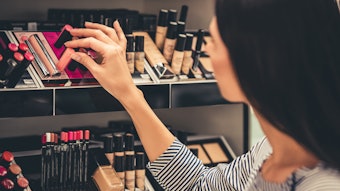The sun care market has exploded in the past few years, with hundreds of products competing for shelf space. Just take a look at the shelves of your local drug or chain stores. This is all due to the recent awareness of the ravages of the sun on the skin and the link to cancer and aging. Dermatologists have proven the direct correlation between the damaging effects of both UVA and UVB rays and skin cancer, as well as attributing the sun as the catalyst for premature aging and of negative impact on skin texture. The sun protection factor (SPF) is a general tool used by the consumer to choose a sunscreen, but this does not ensure the choice of the most effective product. (See Page 32 for more information on sun care.)
Sun screen formulas have improved dramatically throughout the years, and standard, traditional sunscreen ingredients such as zinc oxide and titanium dioxide are still being incorporated in sun care products, while new ingredients proliferate. When examining some of the classic suntan lotions, there’s a strong memory factor in the fragrances that were used.
Sea & Ski had a clean fresh green lavender citrus floral. Coppertone had a fuller, woodier floral with some amber, and Tropic Tan used the fruity tropical notes of melons and peaches with strong coconut undertones. They became reminiscent fragrances of the beach, and brought back good times of basking and baking in the sun. They were subliminal memories of summertime. These products certainly did not contain the newest sunscreen UVA/UVB absorbers, so fragrance interactions were not a wide concern.
The questions today is should these fragrance types be repeated when called to fragrance a new sun care formula? Many perfumers and chemists polled have not noticed a particular problem in covering base notes of these newer formulas. The sunscreen chemicals do not have the malodors of some of the older formulae, and there is a definite trend away from fragrancing these base formulas because of the interaction between certain UV absorbers and some of the more unstable perfume ingredients. Why add to the problems with fragrance?
Further, in reviewing the ratings of the Environmental Working Group, sunscreens that offer the most protection and highest safety also have the least fragrancing components. Some of the newer products today, such as Neutrogena Ultra Sheer Dry-Touch, have a very mild, nondescript and clean floral fragrance that barely covers some of the chalky base notes of the silica and silicone derivatives—let alone the salicylate and the acrylates. In fact, Neutrogena has a huge number of sun care products available, and many are not fragranced. But, for the most part, new sun care products have stayed with a rather pleasant, nondescript fragrance that is clean and fresh. Those with SPF factors of 30 or above use a minimal amount of fragrance to cover the base notes.
But when strategizing brand positioning, fragrance (or lack there of) remains something to consider. The fragrance can definitely help the appeal of the product and elevate the experience, and, because UVA/UVB protection is serious business today, making the right decision can mean success or failure.
Banana Boat, for example, seeks to evoke a tropical island feel, and fruity notes such as mango, melon, coconut and banana work toward that goal. Sweet fruitiness is used to connote a tropical experience. Thus, most products in the Banana Boat line carry a fragrance. Kiss My Face’s SPF 30 product, on the other hand, claims to be the least innocuous choice for consumers with sensitive skin, and, therefore, does not incorporate fragrance. The absence of fragrance in certain products in the brand’s product line supports the “for sensitive” skin positioning goals.
Whether sun care products are minimally fragranced or fragranced to evoke a sensory connection, there are notes to avoid. Avoid some of the volatile citrus notes, spice notes, eugenols [clove-derived essential oils], geraniols [a fragrant liquid unsaturated alcohol], hydroxycitronellals [a natural component of citrus derived essential oils], and oak and tree mosses. Essential oils also add instability. Fruity notes tend to work well as do the lavenders and woody notes, and there are so many synthetic fragrance materials available today that are much more stable in formulas. Generally, a level of 0.5% and below of fragrance in a formula has predictable interactions and results. Of course, there should be extensive stability testing at various temperature levels, and fragrance suppliers must have bases submitted to them for fragrance incorporation and evaluation—for both esthetics and stability and compatibility in the base formula. So much is known about the deleterious effects of the sun on skin, and, therefore, the use of fragrance in sun care products should enhance the performance of the product—simply, to amplify the desire to use sun care and make sun protection a pleasant, fragrant experience. It is the marketer’s challenge to create desire, position an impactful brand and select a compatible, stable and integral fragrance.
Nancy C. Hayden is a chemist and a pharmacist with more than 30 years in the fragrance industry. She worked as a nose for Jovan from the company’s beginnings and as fragrance director for Jovan Beecham until 1988. Currently, she is a consultant to the fragrance and cosmetics industries.










